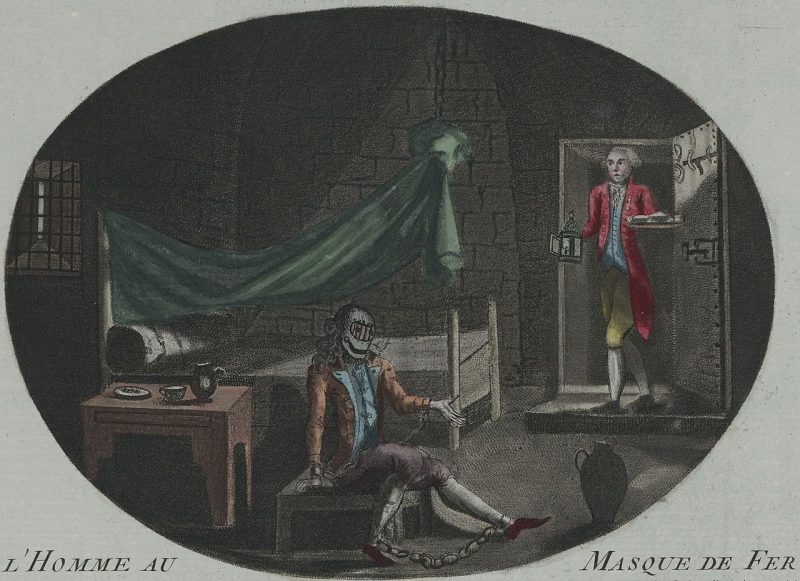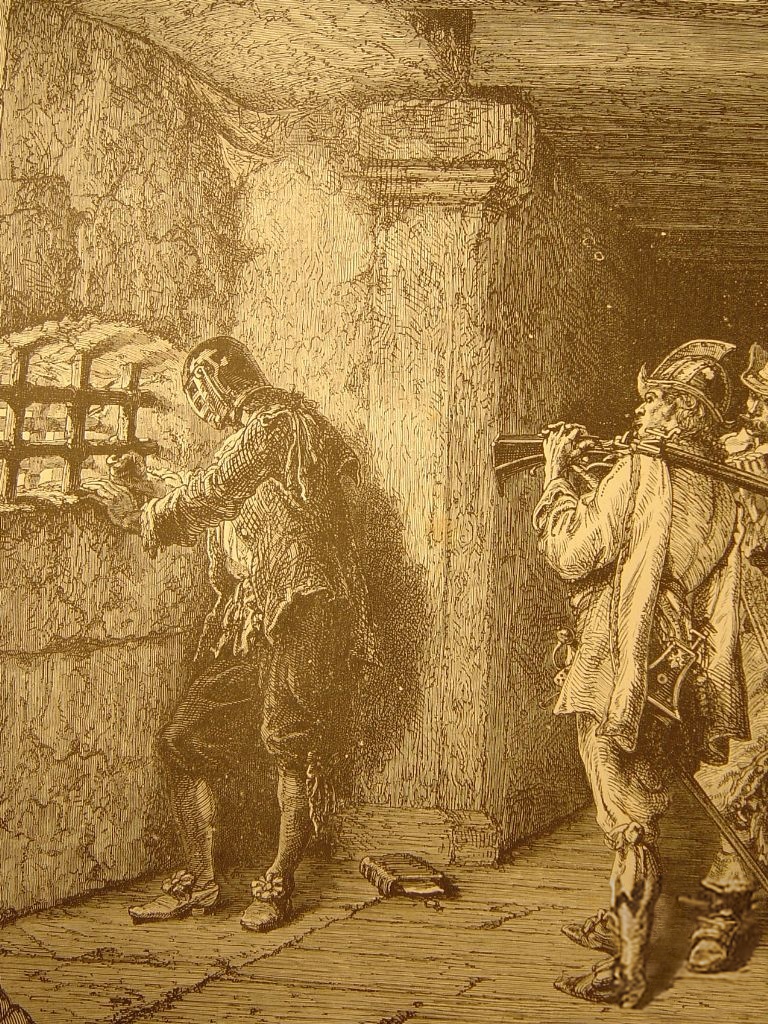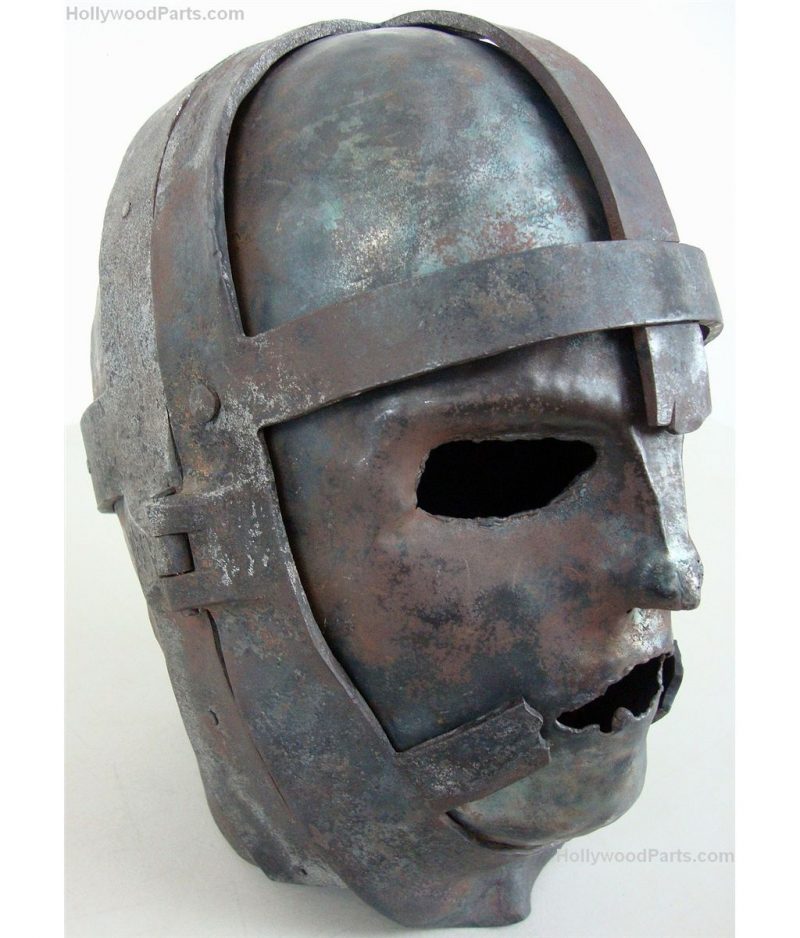Voltaire claimed that the prisoner wore an iron mask and was the older, illegitimate brother of Louis XIV. In the late 1840s, writer Alexandre Dumas elaborated on the theme in the final installment of his Three Musketeers saga: here the prisoner is forced to wear an iron mask and is Louis XIV’s identical twin. Dumas also presented a review of the ideas about the prisoner extant in his time (circa 1840) in the chapter “L’homme au masque de fer” of the sixth volume of his Crimes Célèbres.
The Man in the Iron Mask or L’Homme au Masque de Fer is the offical name given to the prisoner who was arrested as Eustache Dauger in 1669 or 1670 and held in a number of jails, including the Bastille and the Fortress of Pignerol (today Pinerolo, Italy). He was held in the custody of the same jailer, Bénigne Dauvergne de Saint-Mars, for a period of 34 years. He died on 19 November 1703, under the name of Marchioly, during the reign of Louis XIV of France (1643–1715). The possible identity of this man has been thoroughly discussed and has been the subject of many books, as no one ever saw his face because it was hidden by a mask of black velvet cloth.

Louvois instructed Saint-Mars to prepare a cell with multiple doors, one closing upon the other, which were to prevent anyone from the outside listening in. Saint-Mars himself was to see Dauger only once a day in order to provide food and whatever else he needed. Dauger was also to be told that if he, Dauger, spoke of anything other than his immediate needs he would be killed, but, according to Louvois, the prisoner should not require much since he was “only a valet”.
Historians have noted that the name Eustache Dauger was written in a handwriting different from the rest of the text, suggesting that a clerk wrote the letter under Louvois’ dictation, while a third party, very likely the minister himself, added the name afterwards.

The first rumours of the prisoner’s identity (that he was a Marshal of France) began to circulate at this point. According to many versions of this legend, the prisoner wore the mask at all times.
The prison at Pignerol, like the others at which Dauger was later held, was used for those who were considered an embarrassment to the state and usually held only a handful of prisoners at a time.
Saint-Mars’ other prisoners at Pignerol included Count Ercole Antonio Mattioli (or Matthioli), an Italian diplomat who had been kidnapped and jailed for double-crossing the French over the purchase of the important fortress town of Casale on the Italian border. There was also Nicolas Fouquet, Marquis of Belle-Île, a former superintendent of finances, who had been jailed by Louis XIV, on the charge ofembezzlement; and the Marquis de Lauzun, who had become engaged to the Duchess of Montpensier, a cousin of the King, without the King’s consent. Fouquet’s cell was above that of Lauzun.
n his letters to Louvois, Saint-Mars describes Dauger as a quiet man, giving no trouble, “disposed to the will of God and to the king”, compared to his other prisoners who were either always complaining, constantly trying to escape, or simply mad.
Dauger was not always isolated from the other prisoners. Wealthy and important ones usually had manservants; Fouquet for instance was served by a man called La Rivière. These servants, however, would become as much prisoners as their masters and it was thus difficult to find people willing to volunteer for such an occupation. Since La Rivière was often ill, Saint-Mars applied for permission for Dauger to act as servant for Fouquet. In 1675 Louvois gave permission for such an arrangement on condition that he was to serve Fouquet only while La Rivière was unavailable and that he was not to meet anyone else; for instance, if Fouquet and Lauzun were to meet, Dauger was not to be present.

The fate of the mysterious prisoner – and the extent of the precautions his jailers took – created significant interest and many legends. Many theories are in existence and several books have been written about the case. Some were presented after the existence of the letters was widely known. Later commentators have still presented their own theories, possibly based on embellished versions of the original tale.

Voltaire claimed that the prisoner was a son of Anne of Austria and Cardinal Mazarin, and therefore an illegitimate half-brother of King Louis XIV. However, the authenticity of this claim is uncertain. Alexandre Dumas used this theory in his book The Vicomte de Bragelonne, but made the prisoner an identical twin of Louis XIV. This book has served as the basis – even if loosely adapted – for many film versions of the story.
Hugh Ross Williamson argues that the man in the iron mask was actually the father of Louis XIV. According to this theory, the “miraculous” birth of Louis XIV in 1638 would have come after Louis XIII had been estranged from his wife for 14 years. Furthermore, the king was old, weak, ill, and not expected to live much longer, and may have been impotent, which suggests that Louis XIII was not the father.
The suggestion is that the King’s minister, Cardinal Richelieu, had arranged for a substitute, probably an illegitimate son or grandson of Henry IV, to become intimate with the queen and father an heir. At the time, the heir presumptive was Louis XIII’s brother Gaston d’Orléans, who was also Richelieu’s enemy. If Gaston became King, Richelieu would quite likely have lost both his job as minister and his life, so it was in his interests to thwart Gaston’s ambitions. Louis XIII also hated Gaston and might have agreed to the scheme, and the queen would have had the same interest, as Gaston would have removed her from any influence.
In 1801, revolutionary legislator Pierre Roux-Fazillac stated that the tale of the masked prisoner was an amalgamation of the fates of two separate prisoners, Ercole Antonio Mattioli (see below) and an imprisoned valet named “Eustache D’auger”.
In his letter to Saint-Mars announcing the imminent arrival of the prisoner who would become the “man in the iron mask,” Louvois gave his name as “Eustache Dauger” and historians have found evidence that a Eustache Dauger was living at the time and was involved in shady and embarrassing events involving people in high places known as l’Affaire des Poisons. His full name was Eustache Dauger de Cavoye.
n April 1659, Eustache and Guiche were invited to an Easter weekend party at the castle of Roissy-en-Brie. By all accounts it was a “debauched” affair of merry-making, with the men involved in all sorts of “sordid” activities, including attacking a man who claimed to be Cardinal Mazarin’s attorney. It was also claimed, among other things, that a black mass was enacted, and that a pig was baptized as “carp” in order to allow them to eat pork on Good Friday. Other activities, such as heterosexual and homosexual sex, may also have taken place.
When news of these events became public an enquiry was held and the various perpetrators jailed or exiled. There is no record as to what happened to Dauger, but in 1665, near the Château de Saint-Germain-en-Laye, he allegedly killed a young page boy in a drunken brawl involving the Duc de Foix. The two men claimed that they had been provoked by the boy who was drunk, but the fact that the killing took place near a castle where the King was staying meant that this was not a good enough explanation and, as a result, Dauger was forced to resign his commission.
Dauger’s mother died shortly afterwards. In her will, written a year previously, she passed over her eldest surviving sons, Eustache and Armand, leaving the bulk of the estate to their younger brother Louis. Eustache was restricted in the amount of money to which he had access, having built up considerable debts, and left with barely enough for “food and upkeep.” As titular head of the family, he had come into some small estates, but gave these up to Louis, who provided him with an additional annual payment.

The records show that during the enquiry the investigators were told about a supplier of poisons, a surgeon named Auger, and Duvivier became convinced that Dauger de Cavoye, disinherited and short of money, had become Auger, the supplier of poisons, and subsequently Dauger, the man in the mask.
In a letter sent by Louvois to Saint-Mars, shortly after Fouquet’s death, while in prison (with Dauger acting as his valet), the minister adds a note in his own handwriting, asking how Dauger performed certain acts that Saint-Mars had mentioned in a previous correspondence (now lost) and “how he got the drugs necessary to do so”. Duvivier suggested that Dauger may have poisoned Fouquet as part of a complex power-struggle between Louvois and his rival Colbert.
However, evidence has emerged that Dauger de Cavoye actually died in the Prison Saint-Lazare, an asylum run by monks which many families used in order to imprison their “black sheep”. Documents have survived indicating that Dauger de Cavoye was held at Saint-Lazare in Paris at about the same time that Dauger, the man in the mask, was taken into custody in Pignerol, hundreds of miles away in the south.
These include a letter sent to Dauger de Cavoye’s sister, the Marquise de Fabrègues, dated 20 June 1678, which is filled with self-pity as Eustache complains about his treatment in prison, where he has been held for 10 years, and how he was deceived by their brother Louis and Clérac, their brother-in-law and the manager of Louis’ estate. A year later, he wrote a letter to the King, outlining the same complaints and making a similar request for freedom. The best the King would do, however, was to send a letter to the head of Saint-Lazare telling him that “M. de Cavoye should have communication with no one at all, not even with his sister, unless in your presence or in the presence of one of the priests of the mission”. The letter was signed by the King and Colbert.
A poem written by the Comte de Brienne, himself an inmate at the time, indicates that Eustache Dauger de Cavoye died as a result of heavy drinking in the late 1680s. Historians consider all this proof enough that he was not involved in any way with the man in the mask.

Δεν υπάρχουν σχόλια:
Δημοσίευση σχολίου